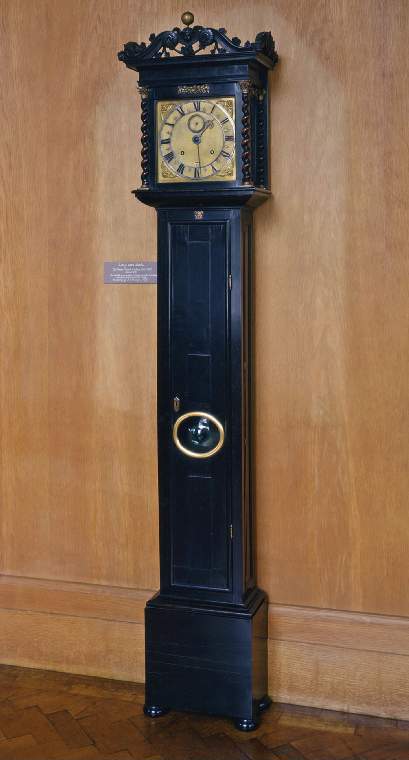Current Location: In storage
Titles
Roman Striking Longcase Clock
Maker(s)
Production:
Knibb, Joseph
(Clockmaker)
Entities
Categories
Description
Longcase clock with month movement and Roman notation striking.
Dial: gilt dial plate 10 inches square with engraved wheatear border, matted centre and cherub spandrels. Silver skeleton chapter ring with four o'clock shown IV, indicating that the clock has roman striking, and the minutes numbered individually. Silver sec¬onds ring. Faceted blued steel hands of the second type as classified by Lee, the circular hour hand. The day of the month shown through a square aperture immediately about VI. Signed at the base of the dial ‘Joseph Knibb Londini fecit'.
Movement: Month duration movement with five wheel going train and four wheel striking train. Roman strik¬ing, a Knibb invention which utilizes a small high pitched bell for the ‘I's and a larger, deeper toned bell for the ‘V's. This requires only 30 blows for twelve hours compared with 78 for conventional stri¬king, hence the use of a four wheel striking train. Butterfly nut adjustment at top of pendulum suspen¬sion. Separate cock for pallet arbor. The movement was not provided with maintaining power.
Case: Carcase of oak veneered with ebony except for sides of plinth which are veneered with ebonised fruit wood. Ebonised twist columns to hood. Hood con¬verted from rising to sliding forward but the grooves remain in the hood. The top board has been replaced, probably because the original contained a sound aperture covered with hessian. The side win¬dows are of the early type, the same height as the front opening. There are very finely carved ebonised crestings to front and sides of the hood. The trunk door and sides with raised panels. The trunk door lock and brass hinges are later replace¬ments. The bun feet also are probably replacements. Fine gilt metal mounts:- corinthian capitals and bases, swags between the capitals, finials, rare grotesque mask mount above trunk door and lenticle frame.
Notes
History note: Unknown before testator
Legal notes
Bequeathed by S.E. Prestige
Measurements and weight
Height: 209.6 cm
Height: 6'10 ½ ft
Acquisition and important dates
Method of acquisition: Bequeathed
(1965)
by
Prestige, Sidney Ernest
Dating
17th Century, Late
Charles II
Production date:
circa
AD 1678
Components of the work
Mounts
composed of
gilt metal
Case
composed of
ebony
oak
Ring
composed of
silver
Inscription or legends present
- Text: Joseph Knibb Londini fecit
- Location: Basis of the dial
- Method of creation: Engraved
- Type: Signature
References and bibliographic entries
Identification numbers
Accession number: M.2-1965
Primary reference Number: 137656
Stable URI
Audit data
Created: Saturday 6 August 2011
Updated: Wednesday 22 January 2025
Last processed: Tuesday 13 May 2025
Associated departments & institutions
Owner or interested party:
The Fitzwilliam Museum
Associated department:
Applied Arts




